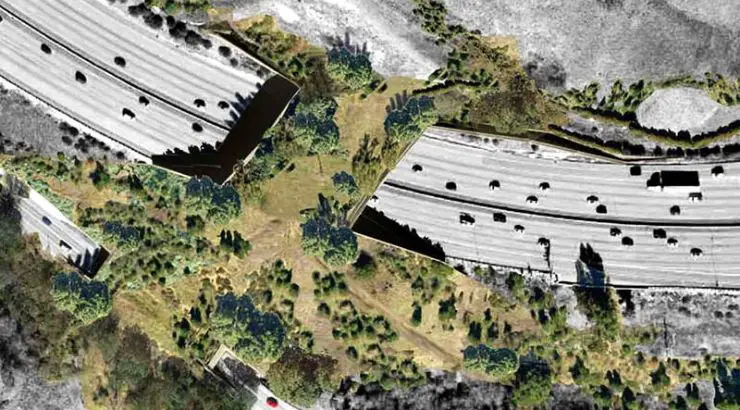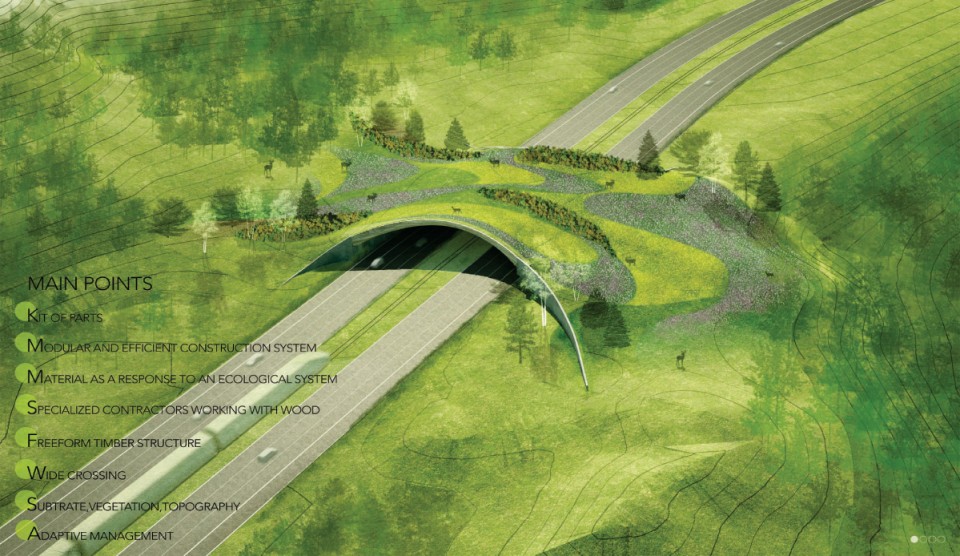Animals
California Set to Build World’s Largest Animal Bridge Over Major Highway Near L.A.
The Liberty Canyon Wildlife Crossing will be the world’s largest animal bridge.

(TMU) — When people typically imagine Southern California, a few things come to mind: vast freeways, heavy traffic, the storied SoCal car culture, and a huge urban expanse surrounded by suburbia and covered in pavement.
Lost in outsiders’ popular perception of the Greater Los Angeles Metropolitan Area is the vast wildlife that once resided where suburban towns have been built. To this day, the Santa Monica Mountains looming above the region’s communities still teem with wildlife such as large raptors, mountain lions, bears, coyote, deer, lizards, and snakes—but their numbers have rapidly faded in recent years.
Now, transportation officials and conservationists hope that they can prevent the extinction of the region’s endemic species with an ambitious plan to build a massive animal overpass above Southern California’s massive freeway, the U.S. 101.

The Liberty Canyon Wildlife Crossing along the 101, slated to stretch 200 feet above 10 lanes of busy highway, will lie just 35 miles northwest of downtown L.A. in Agoura Hills, a town near the border dividing Los Angeles and Ventura counties, and will be both the world’s largest animal overpass and the very first of its kind lying near a major city.
Gorgeous Mountain Lion Strolls Through a California Backyard — Full Story: http://t.co/90f5eWNN8e #SaveLACougars pic.twitter.com/uev0VhzYsg
— National Wildlife Federation (@NWF) December 22, 2014
Officials and experts hope that it will not only preserve the shrinking biodiversity of the region but will also prevent creatures like famous local mountain lions P-22 and P-61 from being kept in isolation, afraid of roaming their natural habitat and meeting mates or worse, risking becoming roadkill just to cross the massive thoroughfares.
Since 2002, the National Park Service has been studying over 50 mountain lions in the Santa Monica Mountains, which run along the Ventura County and the Malibu Coast through the middle of Los Angeles to Hollywood’s Griffith Park, where P-22 now lives. Scientists who’ve tracked the big cats via GPS have expressed alarm over how the animals are being trapped in the increasingly urbanized, fragmented mountain region.
Beth Pratt of the National Wildlife Federation told the Associated Press:
“When the freeway went in, it cut off an ecosystem. We’re just now seeing impacts of that.
“They can’t get out of here to get dates, and cats can’t get in to get dates. … For those of us in L.A., having a romance prospect quashed by traffic is something we can all relate to.”
On the Save LA Cougars website run by the federation, “P-22”—whom Pratt calls “the Brad Pitt of the cougar world”—explains:
“I want a family of my own and the #SaveLACougars campaign seems to be my only hope. I don’t want to be a downer, but my whole species could go extinct if the Wildlife Crossing isn’t built soon and it would be huge shame if our devilishly handsome tribe totally disappeared. I’m asking for help because us cougars really need it.”
As a result of the isolation faced by the big cats, their genetic collapse is becoming imminent. Thanks to habitat loss, the mountain lions could be extinct within 15 years due to inbreeding, according to a study by the National Park Service, UCLA, and UC Davis. And while P-22 is confined to Griffith Park, which lies dozens of miles from the envisioned bridge, his relatives would greatly benefit from it, Pratt explained.
Sad news:A month after mountain lion P-39 was killed when she was struck on an LA freeway, her kitten P-52 met the same fate on the same freeway. http://4.nbcla.com/KXW1ajn
Posted by NBC LA on Thursday, January 5, 2017
The $87 million bridge entered its final design phase last month and is set for groundbreaking within two years and completion by 2023, according to California Department of Transportation engineer Sheik Moinuddin. Construction will mainly take place at night, preventing commuters the nightmarish prospect of bumper-to-bumper traffic jams along other highways.
Over $13.5 million in private funding has also been raised for the project, with officials offering naming rights to any local individuals or entities who can give a major donation. The remaining 20 percent of funds will come from public funds slated toward conservation projects, officials said.
Architect Clark Stevens hopes that despite the 300,000 cars that traverse that particular stretch of the 101 every day, the animal will be completely shielded from the noise and lights from the traffic below. Stevens is working alongside engineers and biologists who are designing berms and hollows with high-edges specifically for that purpose.
Stevens explained:
“Ideally the animals will never know they’re on a bridge … It’s landscape flowing over a freeway. It’s putting back a piece of the ecosystem that was lost.
Every hole in the freeway ought to be exploited. It’s a game of odds. The more options animals have, the better off they’ll be.”
By Elias Marat | Creative Commons | TheMindUnleashed.com
Typos, corrections and/or news tips? Email us at Contact@TheMindUnleashed.com

